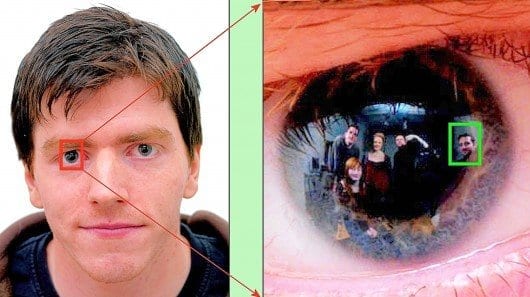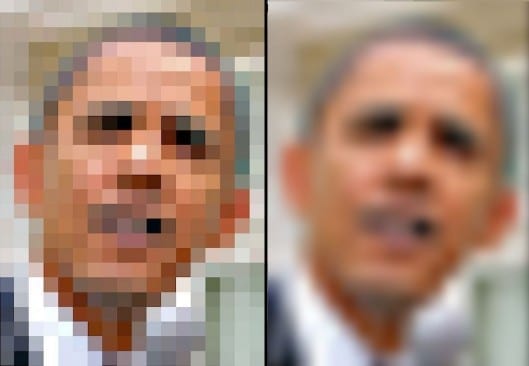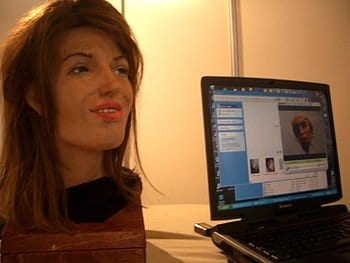
The worst has happened. You receive an emailed kidnap demand with a picture of your loved one in dire straits.
You contact the authorities, and in a flash (relatively speaking), they have identified the kidnapper and possibly some accomplices, and are well on their way toward recovering the victim. How did this happen? By identifying the faces of the kidnappers caught in the reflection of your loved one’s eyes.
The scenario above isn’t yet standard practice, but the basic technology for accomplishing the task now exists. Familiar faces can be recognized from a very small number of pixels, as small as 7 x 10 pixels in one study. A very familiar example appears below. The image on the left has 16 x 20 pixel resolution, while on the right the same image is blurred to make recognition easier.
It is now commonplace for digital cameras to have 10-50 megapixel CMOS sensors. There is even a smartphone, the Nokia Lumia 1020, that has a 41-MP sensor. (Although this camera automatically generates an oversampled 5-MP image from the raw data, the raw data is still available for use.)
A 50 mm equivalent lens covers a horizontal angle of about 40 degrees. With a 40-MP sensor (and good optics), each pixel is about one-third of a minute of arc in size, enabling resolution about five times more acute than that of the human eye. In addition, a good picture captures everything within the bit depth of the pixels, whereas our eyes have a very small area of high resolution on the retina, and our brains fill in the details, often incorrectly. A camera captures a lot of information which we cannot “see at a glance,” or even by careful examination.
A study just carried out by Dr. Rob Jenkins of the University of York and Christie Kerr of the University of Glasgow, both in the UK, has found that the picture of a high-end camera is capable of seeing images reflected from the corneas of a subject being photographed. The images, which can be of high enough quality to identify people by their faces, cover most of the area in front of the subject, owing to the curvature of the cornea. In essence, a fisheye view of the entire region in front of the subject can be found in the image of the subject’s eyes.
While there are applications which would benefit society, there are also many potential uses with obvious “Big Brother” privacy issues.
The Latest on: Facial recognition
[google_news title=”” keyword=”Facial recognition” num_posts=”10″ blurb_length=”0″ show_thumb=”left”]
via Google News
The Latest on: Facial recognition
- Three-judge panel says cops can force you to unlock your phone using your fingerprint or faceon April 27, 2024 at 2:46 pm
An appeals court ruling with limited reach allows cops to force suspects to unlock their phones using fingerprint or facial recognition.
- Facial recognition likely for TS EAPCETon April 27, 2024 at 11:25 am
A student will be permitted for the examination if the captured photograph matches the one in the registration form.
- Metro board ponders facial recognition, other security measures after subway killingon April 26, 2024 at 3:00 am
Could AI have prevented the killing of a woman on an L.A. subway. Metro is looking at facial recognition technology, fare gates and new station designs to address security concerns amid a wave of ...
- China orders hotels to scrap facial recognition over privacy fearson April 25, 2024 at 1:31 pm
Cities in China are banning hotels from using facial recognition, a sign that the government is recognizing the public’s privacy concerns.
- Facial Recognition at Airports vs. Facial Analysis at Events: What to Knowon April 25, 2024 at 12:05 pm
As Congress debates the use of facial identification for airport security, planners should know how that technology differs from the one that measures attendee engagement during sessions.
- Why aren’t California lawmakers banning police from using facial recognition technology? | Opinionon April 25, 2024 at 6:00 am
Legislative half measures, like Assembly Bill 1814, all but guarantee that police will make more wrongful arrests based off of flawed technology.
- Shanghai Bans Mandatory Use of Facial Recognition in Hotelson April 24, 2024 at 10:04 pm
Local authorities say forcing guests to use face scanners during check-in will be “strictly forbidden,” as the practice represents a privacy and data security risk.
- AI can apparently predict a person's political stance just by reading their faceon April 24, 2024 at 3:50 pm
A study recently published in the peer-reviewed American Psychologist journal claims that a combination of facial recognition and artificial intelligence technology can accurately assess a person’s ...
- Supermarket facial recognition failure—why automated systems must put the human factor firston April 22, 2024 at 8:37 am
The incident of a woman misidentified by facial recognition technology at a Rotorua supermarket should have come as no surprise.
- Smart gun will put fingerprint, facial recognition technology to workon April 18, 2024 at 6:00 am
The Biofire Smart Gun features both built-in fingerprint and infrared facial recognition technology that only permits use by "authorized" individuals, according to the company.
via Bing News










